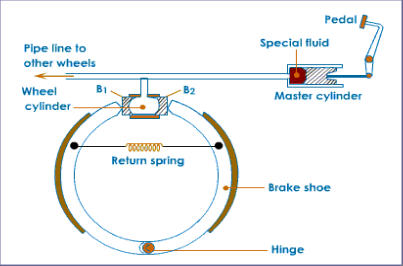←
Automobile Engineering
Hydraulic Brakes
Introduction:
This system uses a brake fluid (Preferably ethylene glycol) to transfer the pressure applied by the operator from the controlling unit to the actual brake mechanism, which is usually at or near the wheel of the vehicle. Most vehicles in India prefer to have drum brakes on rear wheels while disk brakes on the front wheels attached to the hydraulic controlling unit.
Construction:
- Brake pedal or lever.
- A pushrod (also called an actuating rod).
- A master cylinder assembly containing a piston assembly (made up of either one or two pistons, a return spring, a series of gaskets/ O-rings and a fluid reservoir).
- Reinforced hydraulic lines.
- Brake caliper assembly consisting of one or two hollow aluminum or chrome-plated steel pistons (called caliper pistons), a set of thermally conductive brake pads and a rotor (also called a brake disc) or drum attached to an axle.
- The system is filled with a glycol-ether based brake fluid.

System Operation:
- As the brake pedal is pressed, a pushrod exerts force on the piston(s) in the master cylinder causing fluid from the brake fluid reservoir to flow into a pressure chamber.
- This forces fluid through the hydraulic lines toward one or more calipers where it acts upon one or two caliper pistons sealed by one or more seated O-rings which prevent the escape of any fluid from around the piston.
- Heat is dissipated through brake pads which are made up of special heat tolerant materials such as Kevlar or sintered glass.
Important Considerations:
- Hydraulic systems are smaller and less expensive than the air brake systems.
- Hydraulic fluid should be in-compressible. Also the hydraulic system should be air tight such that no vapor is introduced in the system.
- Hydraulic fluid must resist vaporization at high temperatures.
- The fluid that is used should be non-corrosive for the surrounding material.
- Elimination of Brake Fade.